Challenges of Canadian Pharmaceutical Policy: A Policy Research Essay
VerifiedAdded on 2020/05/04
|14
|3831
|186
Essay
AI Summary
This policy research essay delves into the challenges within Canadian pharmaceutical policy, with a specific focus on the issue of undisclosed payments made by drug companies to physicians. It examines the historical context of this problem, outlining instances of non-transparency and potential conflicts of interest. The essay provides an overview of current policies, including federal and provincial jurisdictions, and analyzes the implications of these practices on patient care, drug pricing, and ethical considerations. It explores past and present approaches to address the issue, such as regulations, disclosure requirements, and guidelines from medical associations. The essay discusses various regulatory strategies, including command and control, self-regulation, market enhancements, and disclosure, along with their respective limitations and relevance. The research concludes by offering recommendations for improved transparency and accountability within the pharmaceutical industry, aiming to safeguard patient welfare and promote ethical practices.
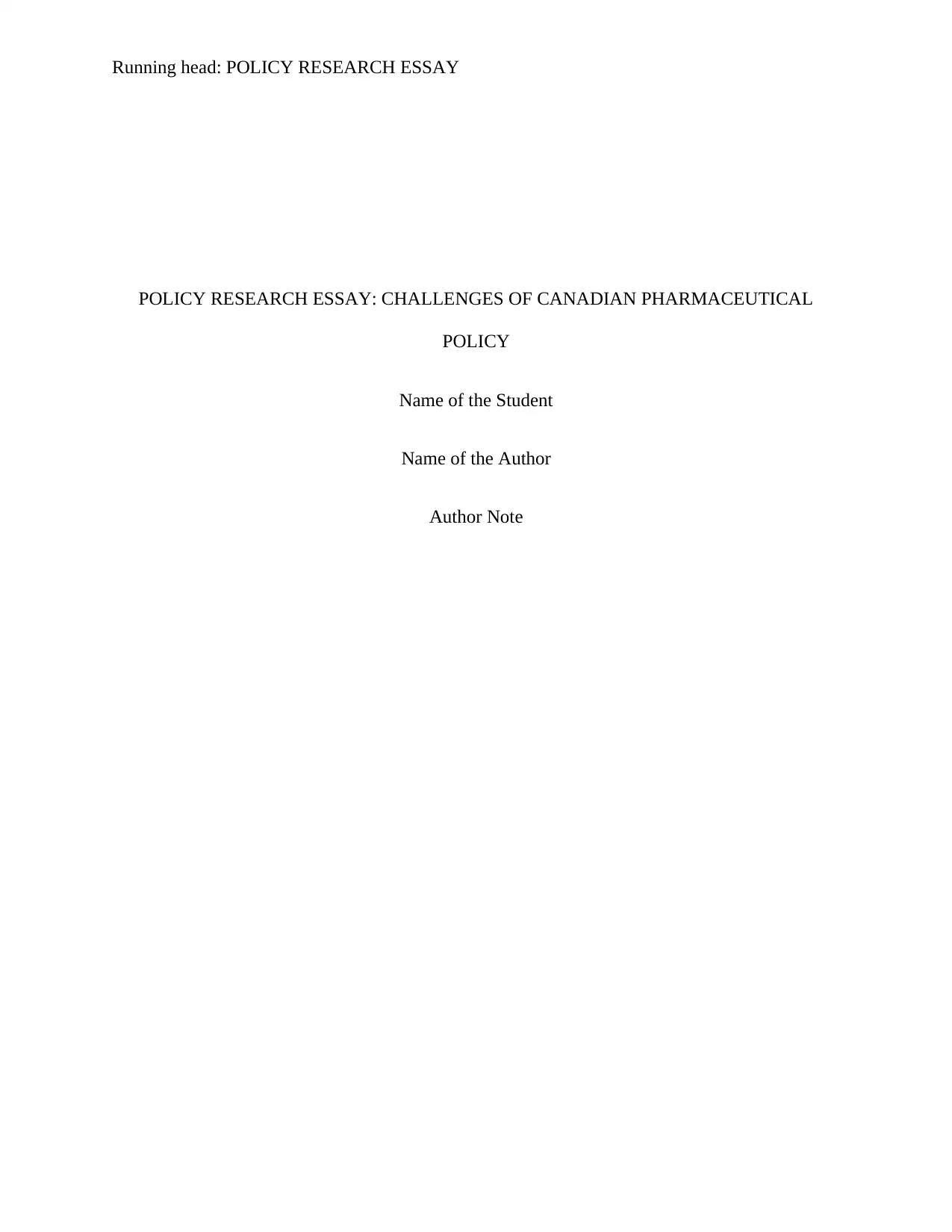
Running head: POLICY RESEARCH ESSAY
POLICY RESEARCH ESSAY: CHALLENGES OF CANADIAN PHARMACEUTICAL
POLICY
Name of the Student
Name of the Author
Author Note
POLICY RESEARCH ESSAY: CHALLENGES OF CANADIAN PHARMACEUTICAL
POLICY
Name of the Student
Name of the Author
Author Note
Paraphrase This Document
Need a fresh take? Get an instant paraphrase of this document with our AI Paraphraser
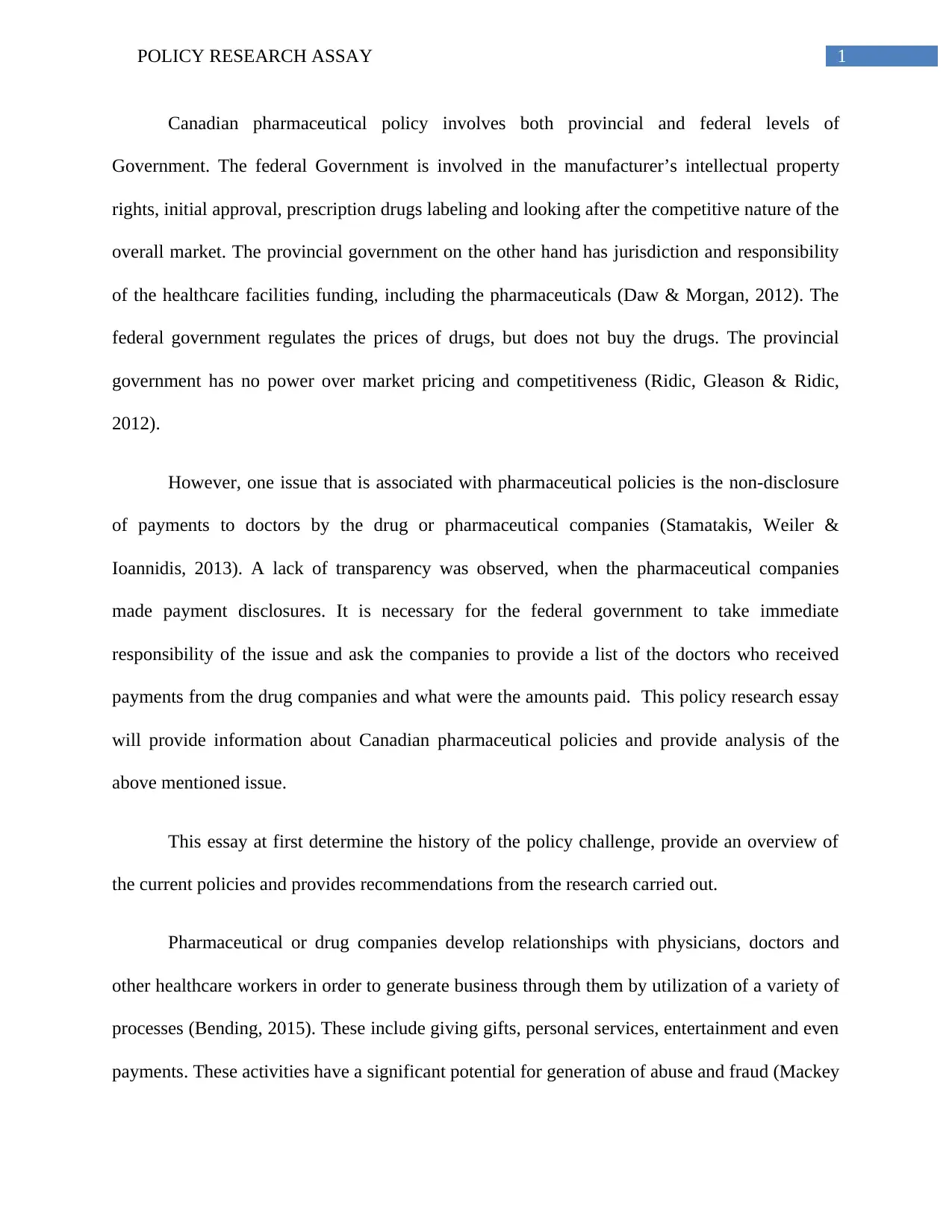
1POLICY RESEARCH ASSAY
Canadian pharmaceutical policy involves both provincial and federal levels of
Government. The federal Government is involved in the manufacturer’s intellectual property
rights, initial approval, prescription drugs labeling and looking after the competitive nature of the
overall market. The provincial government on the other hand has jurisdiction and responsibility
of the healthcare facilities funding, including the pharmaceuticals (Daw & Morgan, 2012). The
federal government regulates the prices of drugs, but does not buy the drugs. The provincial
government has no power over market pricing and competitiveness (Ridic, Gleason & Ridic,
2012).
However, one issue that is associated with pharmaceutical policies is the non-disclosure
of payments to doctors by the drug or pharmaceutical companies (Stamatakis, Weiler &
Ioannidis, 2013). A lack of transparency was observed, when the pharmaceutical companies
made payment disclosures. It is necessary for the federal government to take immediate
responsibility of the issue and ask the companies to provide a list of the doctors who received
payments from the drug companies and what were the amounts paid. This policy research essay
will provide information about Canadian pharmaceutical policies and provide analysis of the
above mentioned issue.
This essay at first determine the history of the policy challenge, provide an overview of
the current policies and provides recommendations from the research carried out.
Pharmaceutical or drug companies develop relationships with physicians, doctors and
other healthcare workers in order to generate business through them by utilization of a variety of
processes (Bending, 2015). These include giving gifts, personal services, entertainment and even
payments. These activities have a significant potential for generation of abuse and fraud (Mackey
Canadian pharmaceutical policy involves both provincial and federal levels of
Government. The federal Government is involved in the manufacturer’s intellectual property
rights, initial approval, prescription drugs labeling and looking after the competitive nature of the
overall market. The provincial government on the other hand has jurisdiction and responsibility
of the healthcare facilities funding, including the pharmaceuticals (Daw & Morgan, 2012). The
federal government regulates the prices of drugs, but does not buy the drugs. The provincial
government has no power over market pricing and competitiveness (Ridic, Gleason & Ridic,
2012).
However, one issue that is associated with pharmaceutical policies is the non-disclosure
of payments to doctors by the drug or pharmaceutical companies (Stamatakis, Weiler &
Ioannidis, 2013). A lack of transparency was observed, when the pharmaceutical companies
made payment disclosures. It is necessary for the federal government to take immediate
responsibility of the issue and ask the companies to provide a list of the doctors who received
payments from the drug companies and what were the amounts paid. This policy research essay
will provide information about Canadian pharmaceutical policies and provide analysis of the
above mentioned issue.
This essay at first determine the history of the policy challenge, provide an overview of
the current policies and provides recommendations from the research carried out.
Pharmaceutical or drug companies develop relationships with physicians, doctors and
other healthcare workers in order to generate business through them by utilization of a variety of
processes (Bending, 2015). These include giving gifts, personal services, entertainment and even
payments. These activities have a significant potential for generation of abuse and fraud (Mackey
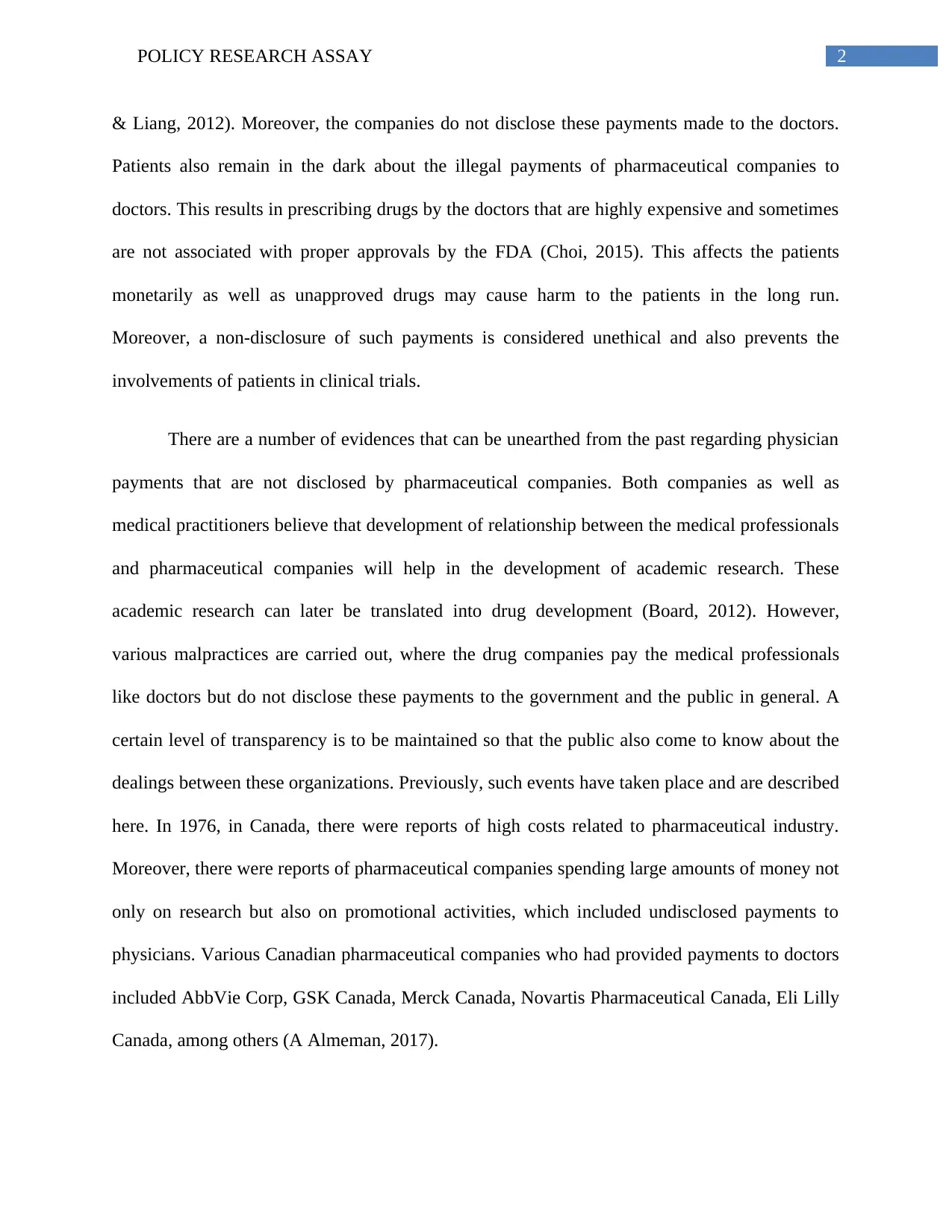
2POLICY RESEARCH ASSAY
& Liang, 2012). Moreover, the companies do not disclose these payments made to the doctors.
Patients also remain in the dark about the illegal payments of pharmaceutical companies to
doctors. This results in prescribing drugs by the doctors that are highly expensive and sometimes
are not associated with proper approvals by the FDA (Choi, 2015). This affects the patients
monetarily as well as unapproved drugs may cause harm to the patients in the long run.
Moreover, a non-disclosure of such payments is considered unethical and also prevents the
involvements of patients in clinical trials.
There are a number of evidences that can be unearthed from the past regarding physician
payments that are not disclosed by pharmaceutical companies. Both companies as well as
medical practitioners believe that development of relationship between the medical professionals
and pharmaceutical companies will help in the development of academic research. These
academic research can later be translated into drug development (Board, 2012). However,
various malpractices are carried out, where the drug companies pay the medical professionals
like doctors but do not disclose these payments to the government and the public in general. A
certain level of transparency is to be maintained so that the public also come to know about the
dealings between these organizations. Previously, such events have taken place and are described
here. In 1976, in Canada, there were reports of high costs related to pharmaceutical industry.
Moreover, there were reports of pharmaceutical companies spending large amounts of money not
only on research but also on promotional activities, which included undisclosed payments to
physicians. Various Canadian pharmaceutical companies who had provided payments to doctors
included AbbVie Corp, GSK Canada, Merck Canada, Novartis Pharmaceutical Canada, Eli Lilly
Canada, among others (A Almeman, 2017).
& Liang, 2012). Moreover, the companies do not disclose these payments made to the doctors.
Patients also remain in the dark about the illegal payments of pharmaceutical companies to
doctors. This results in prescribing drugs by the doctors that are highly expensive and sometimes
are not associated with proper approvals by the FDA (Choi, 2015). This affects the patients
monetarily as well as unapproved drugs may cause harm to the patients in the long run.
Moreover, a non-disclosure of such payments is considered unethical and also prevents the
involvements of patients in clinical trials.
There are a number of evidences that can be unearthed from the past regarding physician
payments that are not disclosed by pharmaceutical companies. Both companies as well as
medical practitioners believe that development of relationship between the medical professionals
and pharmaceutical companies will help in the development of academic research. These
academic research can later be translated into drug development (Board, 2012). However,
various malpractices are carried out, where the drug companies pay the medical professionals
like doctors but do not disclose these payments to the government and the public in general. A
certain level of transparency is to be maintained so that the public also come to know about the
dealings between these organizations. Previously, such events have taken place and are described
here. In 1976, in Canada, there were reports of high costs related to pharmaceutical industry.
Moreover, there were reports of pharmaceutical companies spending large amounts of money not
only on research but also on promotional activities, which included undisclosed payments to
physicians. Various Canadian pharmaceutical companies who had provided payments to doctors
included AbbVie Corp, GSK Canada, Merck Canada, Novartis Pharmaceutical Canada, Eli Lilly
Canada, among others (A Almeman, 2017).
⊘ This is a preview!⊘
Do you want full access?
Subscribe today to unlock all pages.

Trusted by 1+ million students worldwide
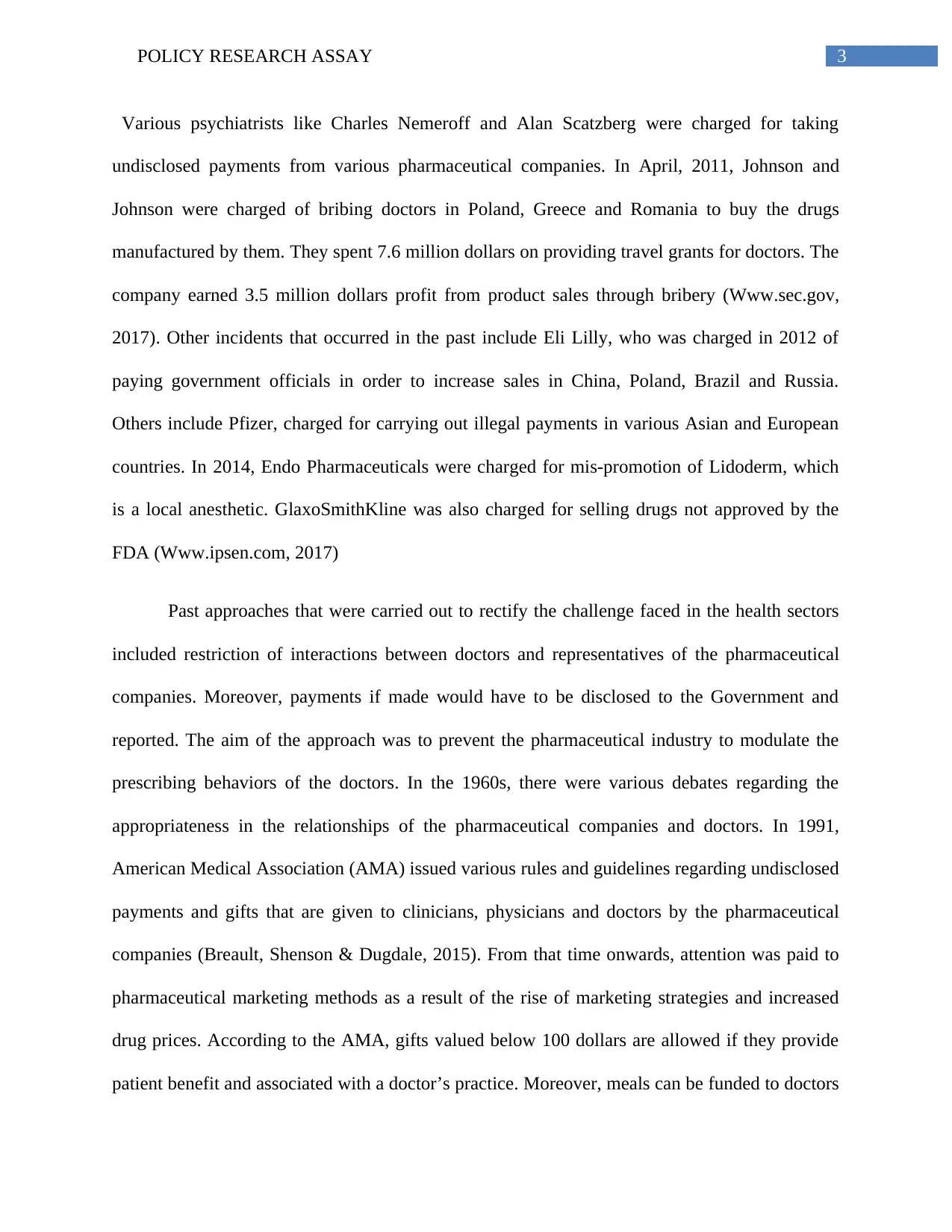
3POLICY RESEARCH ASSAY
Various psychiatrists like Charles Nemeroff and Alan Scatzberg were charged for taking
undisclosed payments from various pharmaceutical companies. In April, 2011, Johnson and
Johnson were charged of bribing doctors in Poland, Greece and Romania to buy the drugs
manufactured by them. They spent 7.6 million dollars on providing travel grants for doctors. The
company earned 3.5 million dollars profit from product sales through bribery (Www.sec.gov,
2017). Other incidents that occurred in the past include Eli Lilly, who was charged in 2012 of
paying government officials in order to increase sales in China, Poland, Brazil and Russia.
Others include Pfizer, charged for carrying out illegal payments in various Asian and European
countries. In 2014, Endo Pharmaceuticals were charged for mis-promotion of Lidoderm, which
is a local anesthetic. GlaxoSmithKline was also charged for selling drugs not approved by the
FDA (Www.ipsen.com, 2017)
Past approaches that were carried out to rectify the challenge faced in the health sectors
included restriction of interactions between doctors and representatives of the pharmaceutical
companies. Moreover, payments if made would have to be disclosed to the Government and
reported. The aim of the approach was to prevent the pharmaceutical industry to modulate the
prescribing behaviors of the doctors. In the 1960s, there were various debates regarding the
appropriateness in the relationships of the pharmaceutical companies and doctors. In 1991,
American Medical Association (AMA) issued various rules and guidelines regarding undisclosed
payments and gifts that are given to clinicians, physicians and doctors by the pharmaceutical
companies (Breault, Shenson & Dugdale, 2015). From that time onwards, attention was paid to
pharmaceutical marketing methods as a result of the rise of marketing strategies and increased
drug prices. According to the AMA, gifts valued below 100 dollars are allowed if they provide
patient benefit and associated with a doctor’s practice. Moreover, meals can be funded to doctors
Various psychiatrists like Charles Nemeroff and Alan Scatzberg were charged for taking
undisclosed payments from various pharmaceutical companies. In April, 2011, Johnson and
Johnson were charged of bribing doctors in Poland, Greece and Romania to buy the drugs
manufactured by them. They spent 7.6 million dollars on providing travel grants for doctors. The
company earned 3.5 million dollars profit from product sales through bribery (Www.sec.gov,
2017). Other incidents that occurred in the past include Eli Lilly, who was charged in 2012 of
paying government officials in order to increase sales in China, Poland, Brazil and Russia.
Others include Pfizer, charged for carrying out illegal payments in various Asian and European
countries. In 2014, Endo Pharmaceuticals were charged for mis-promotion of Lidoderm, which
is a local anesthetic. GlaxoSmithKline was also charged for selling drugs not approved by the
FDA (Www.ipsen.com, 2017)
Past approaches that were carried out to rectify the challenge faced in the health sectors
included restriction of interactions between doctors and representatives of the pharmaceutical
companies. Moreover, payments if made would have to be disclosed to the Government and
reported. The aim of the approach was to prevent the pharmaceutical industry to modulate the
prescribing behaviors of the doctors. In the 1960s, there were various debates regarding the
appropriateness in the relationships of the pharmaceutical companies and doctors. In 1991,
American Medical Association (AMA) issued various rules and guidelines regarding undisclosed
payments and gifts that are given to clinicians, physicians and doctors by the pharmaceutical
companies (Breault, Shenson & Dugdale, 2015). From that time onwards, attention was paid to
pharmaceutical marketing methods as a result of the rise of marketing strategies and increased
drug prices. According to the AMA, gifts valued below 100 dollars are allowed if they provide
patient benefit and associated with a doctor’s practice. Moreover, meals can be funded to doctors
Paraphrase This Document
Need a fresh take? Get an instant paraphrase of this document with our AI Paraphraser
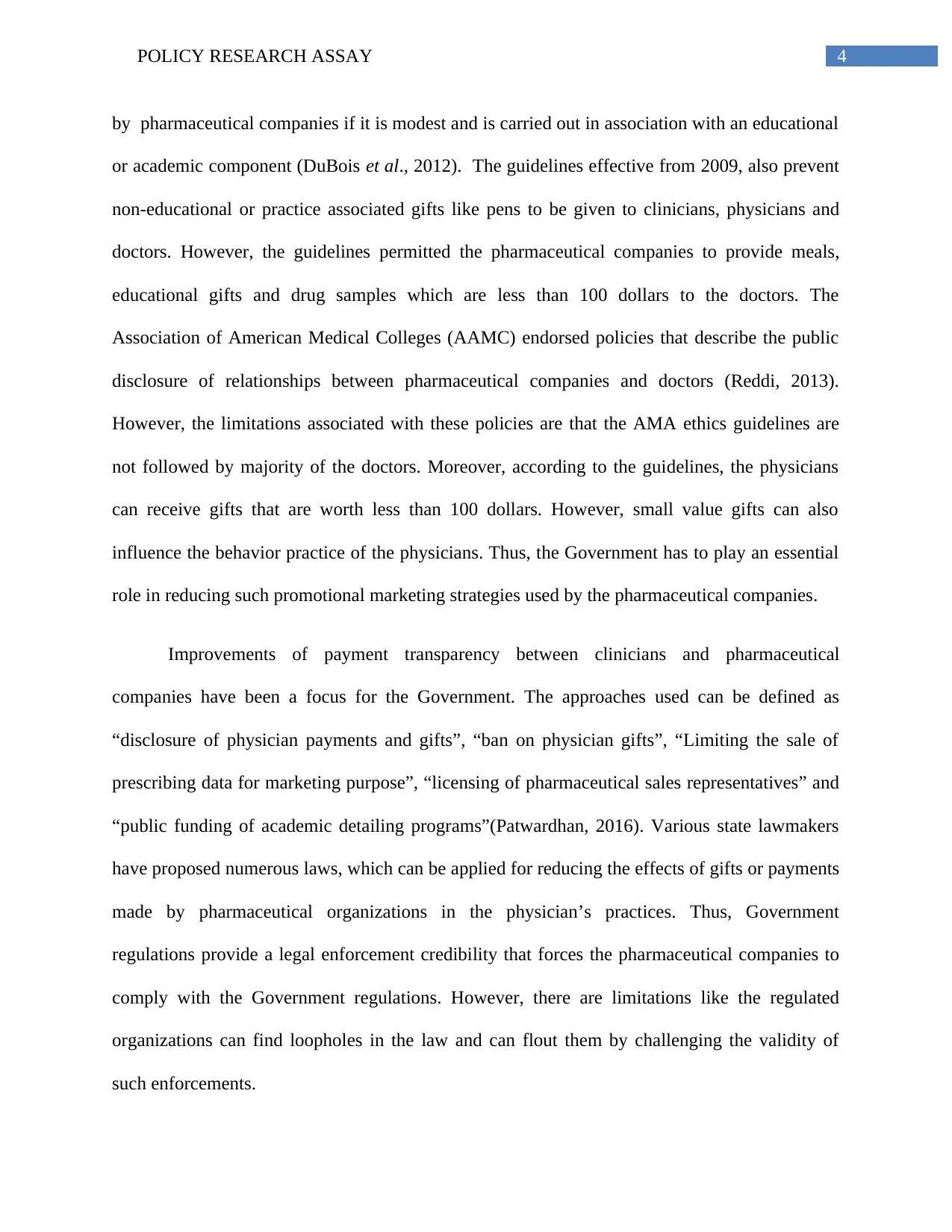
4POLICY RESEARCH ASSAY
by pharmaceutical companies if it is modest and is carried out in association with an educational
or academic component (DuBois et al., 2012). The guidelines effective from 2009, also prevent
non-educational or practice associated gifts like pens to be given to clinicians, physicians and
doctors. However, the guidelines permitted the pharmaceutical companies to provide meals,
educational gifts and drug samples which are less than 100 dollars to the doctors. The
Association of American Medical Colleges (AAMC) endorsed policies that describe the public
disclosure of relationships between pharmaceutical companies and doctors (Reddi, 2013).
However, the limitations associated with these policies are that the AMA ethics guidelines are
not followed by majority of the doctors. Moreover, according to the guidelines, the physicians
can receive gifts that are worth less than 100 dollars. However, small value gifts can also
influence the behavior practice of the physicians. Thus, the Government has to play an essential
role in reducing such promotional marketing strategies used by the pharmaceutical companies.
Improvements of payment transparency between clinicians and pharmaceutical
companies have been a focus for the Government. The approaches used can be defined as
“disclosure of physician payments and gifts”, “ban on physician gifts”, “Limiting the sale of
prescribing data for marketing purpose”, “licensing of pharmaceutical sales representatives” and
“public funding of academic detailing programs”(Patwardhan, 2016). Various state lawmakers
have proposed numerous laws, which can be applied for reducing the effects of gifts or payments
made by pharmaceutical organizations in the physician’s practices. Thus, Government
regulations provide a legal enforcement credibility that forces the pharmaceutical companies to
comply with the Government regulations. However, there are limitations like the regulated
organizations can find loopholes in the law and can flout them by challenging the validity of
such enforcements.
by pharmaceutical companies if it is modest and is carried out in association with an educational
or academic component (DuBois et al., 2012). The guidelines effective from 2009, also prevent
non-educational or practice associated gifts like pens to be given to clinicians, physicians and
doctors. However, the guidelines permitted the pharmaceutical companies to provide meals,
educational gifts and drug samples which are less than 100 dollars to the doctors. The
Association of American Medical Colleges (AAMC) endorsed policies that describe the public
disclosure of relationships between pharmaceutical companies and doctors (Reddi, 2013).
However, the limitations associated with these policies are that the AMA ethics guidelines are
not followed by majority of the doctors. Moreover, according to the guidelines, the physicians
can receive gifts that are worth less than 100 dollars. However, small value gifts can also
influence the behavior practice of the physicians. Thus, the Government has to play an essential
role in reducing such promotional marketing strategies used by the pharmaceutical companies.
Improvements of payment transparency between clinicians and pharmaceutical
companies have been a focus for the Government. The approaches used can be defined as
“disclosure of physician payments and gifts”, “ban on physician gifts”, “Limiting the sale of
prescribing data for marketing purpose”, “licensing of pharmaceutical sales representatives” and
“public funding of academic detailing programs”(Patwardhan, 2016). Various state lawmakers
have proposed numerous laws, which can be applied for reducing the effects of gifts or payments
made by pharmaceutical organizations in the physician’s practices. Thus, Government
regulations provide a legal enforcement credibility that forces the pharmaceutical companies to
comply with the Government regulations. However, there are limitations like the regulated
organizations can find loopholes in the law and can flout them by challenging the validity of
such enforcements.
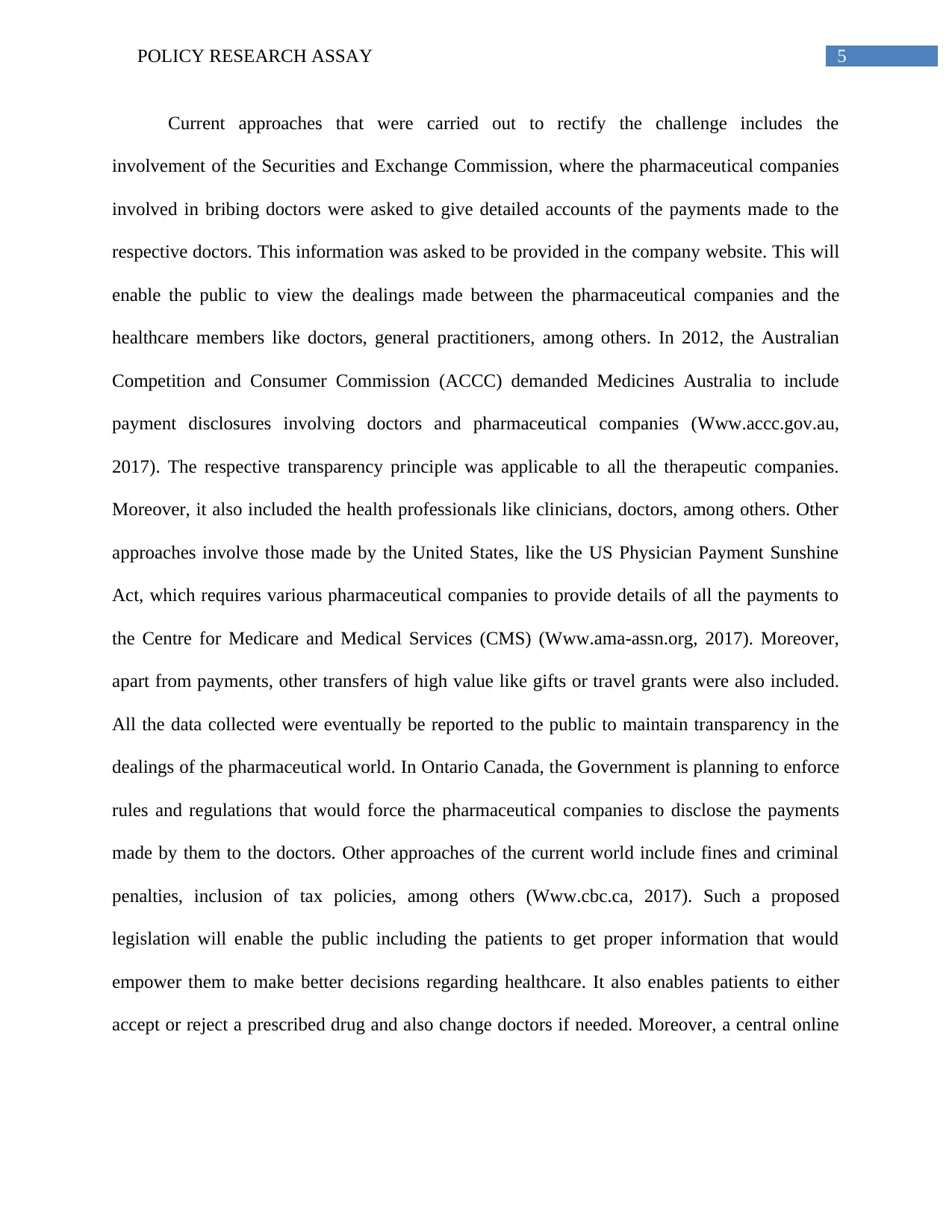
5POLICY RESEARCH ASSAY
Current approaches that were carried out to rectify the challenge includes the
involvement of the Securities and Exchange Commission, where the pharmaceutical companies
involved in bribing doctors were asked to give detailed accounts of the payments made to the
respective doctors. This information was asked to be provided in the company website. This will
enable the public to view the dealings made between the pharmaceutical companies and the
healthcare members like doctors, general practitioners, among others. In 2012, the Australian
Competition and Consumer Commission (ACCC) demanded Medicines Australia to include
payment disclosures involving doctors and pharmaceutical companies (Www.accc.gov.au,
2017). The respective transparency principle was applicable to all the therapeutic companies.
Moreover, it also included the health professionals like clinicians, doctors, among others. Other
approaches involve those made by the United States, like the US Physician Payment Sunshine
Act, which requires various pharmaceutical companies to provide details of all the payments to
the Centre for Medicare and Medical Services (CMS) (Www.ama-assn.org, 2017). Moreover,
apart from payments, other transfers of high value like gifts or travel grants were also included.
All the data collected were eventually be reported to the public to maintain transparency in the
dealings of the pharmaceutical world. In Ontario Canada, the Government is planning to enforce
rules and regulations that would force the pharmaceutical companies to disclose the payments
made by them to the doctors. Other approaches of the current world include fines and criminal
penalties, inclusion of tax policies, among others (Www.cbc.ca, 2017). Such a proposed
legislation will enable the public including the patients to get proper information that would
empower them to make better decisions regarding healthcare. It also enables patients to either
accept or reject a prescribed drug and also change doctors if needed. Moreover, a central online
Current approaches that were carried out to rectify the challenge includes the
involvement of the Securities and Exchange Commission, where the pharmaceutical companies
involved in bribing doctors were asked to give detailed accounts of the payments made to the
respective doctors. This information was asked to be provided in the company website. This will
enable the public to view the dealings made between the pharmaceutical companies and the
healthcare members like doctors, general practitioners, among others. In 2012, the Australian
Competition and Consumer Commission (ACCC) demanded Medicines Australia to include
payment disclosures involving doctors and pharmaceutical companies (Www.accc.gov.au,
2017). The respective transparency principle was applicable to all the therapeutic companies.
Moreover, it also included the health professionals like clinicians, doctors, among others. Other
approaches involve those made by the United States, like the US Physician Payment Sunshine
Act, which requires various pharmaceutical companies to provide details of all the payments to
the Centre for Medicare and Medical Services (CMS) (Www.ama-assn.org, 2017). Moreover,
apart from payments, other transfers of high value like gifts or travel grants were also included.
All the data collected were eventually be reported to the public to maintain transparency in the
dealings of the pharmaceutical world. In Ontario Canada, the Government is planning to enforce
rules and regulations that would force the pharmaceutical companies to disclose the payments
made by them to the doctors. Other approaches of the current world include fines and criminal
penalties, inclusion of tax policies, among others (Www.cbc.ca, 2017). Such a proposed
legislation will enable the public including the patients to get proper information that would
empower them to make better decisions regarding healthcare. It also enables patients to either
accept or reject a prescribed drug and also change doctors if needed. Moreover, a central online
⊘ This is a preview!⊘
Do you want full access?
Subscribe today to unlock all pages.

Trusted by 1+ million students worldwide
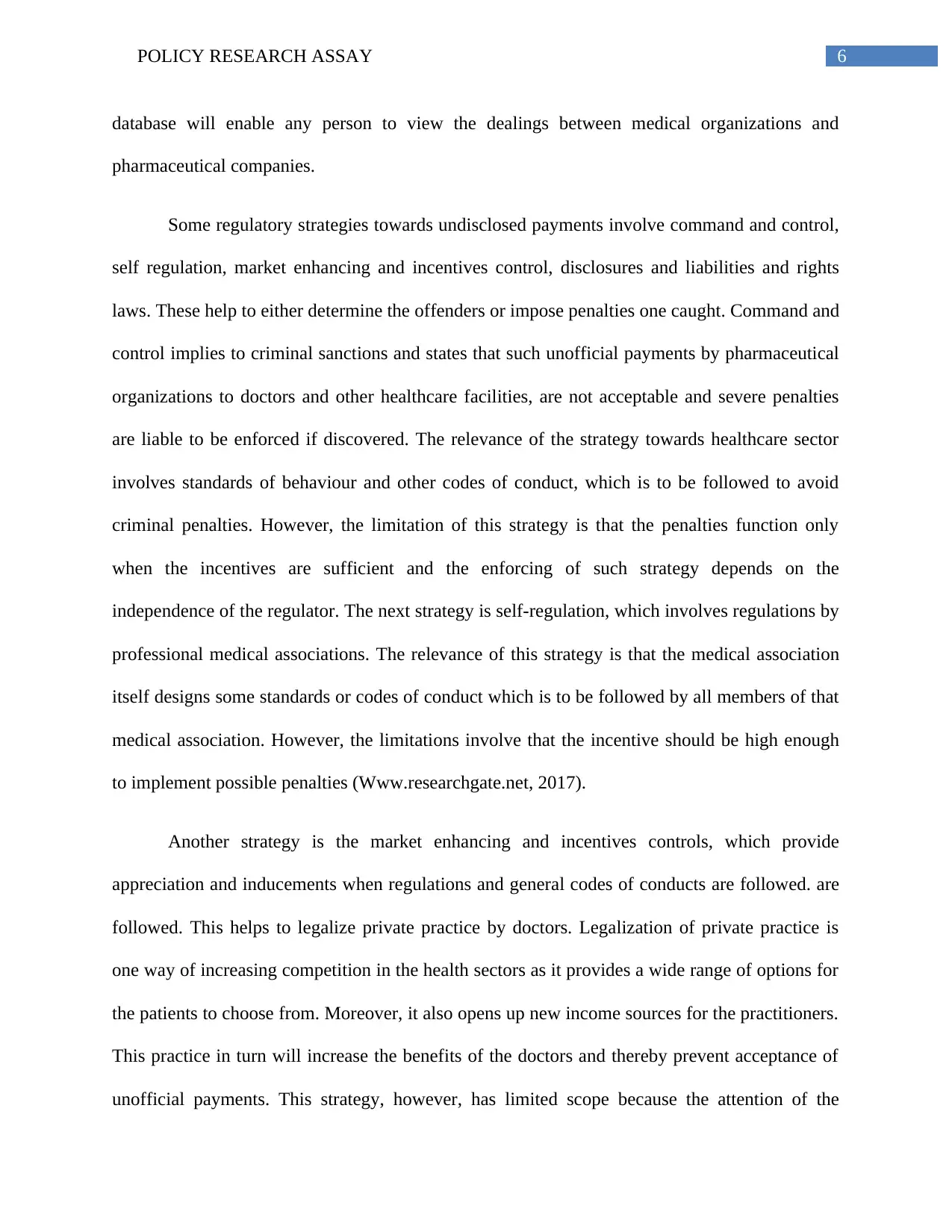
6POLICY RESEARCH ASSAY
database will enable any person to view the dealings between medical organizations and
pharmaceutical companies.
Some regulatory strategies towards undisclosed payments involve command and control,
self regulation, market enhancing and incentives control, disclosures and liabilities and rights
laws. These help to either determine the offenders or impose penalties one caught. Command and
control implies to criminal sanctions and states that such unofficial payments by pharmaceutical
organizations to doctors and other healthcare facilities, are not acceptable and severe penalties
are liable to be enforced if discovered. The relevance of the strategy towards healthcare sector
involves standards of behaviour and other codes of conduct, which is to be followed to avoid
criminal penalties. However, the limitation of this strategy is that the penalties function only
when the incentives are sufficient and the enforcing of such strategy depends on the
independence of the regulator. The next strategy is self-regulation, which involves regulations by
professional medical associations. The relevance of this strategy is that the medical association
itself designs some standards or codes of conduct which is to be followed by all members of that
medical association. However, the limitations involve that the incentive should be high enough
to implement possible penalties (Www.researchgate.net, 2017).
Another strategy is the market enhancing and incentives controls, which provide
appreciation and inducements when regulations and general codes of conducts are followed. are
followed. This helps to legalize private practice by doctors. Legalization of private practice is
one way of increasing competition in the health sectors as it provides a wide range of options for
the patients to choose from. Moreover, it also opens up new income sources for the practitioners.
This practice in turn will increase the benefits of the doctors and thereby prevent acceptance of
unofficial payments. This strategy, however, has limited scope because the attention of the
database will enable any person to view the dealings between medical organizations and
pharmaceutical companies.
Some regulatory strategies towards undisclosed payments involve command and control,
self regulation, market enhancing and incentives control, disclosures and liabilities and rights
laws. These help to either determine the offenders or impose penalties one caught. Command and
control implies to criminal sanctions and states that such unofficial payments by pharmaceutical
organizations to doctors and other healthcare facilities, are not acceptable and severe penalties
are liable to be enforced if discovered. The relevance of the strategy towards healthcare sector
involves standards of behaviour and other codes of conduct, which is to be followed to avoid
criminal penalties. However, the limitation of this strategy is that the penalties function only
when the incentives are sufficient and the enforcing of such strategy depends on the
independence of the regulator. The next strategy is self-regulation, which involves regulations by
professional medical associations. The relevance of this strategy is that the medical association
itself designs some standards or codes of conduct which is to be followed by all members of that
medical association. However, the limitations involve that the incentive should be high enough
to implement possible penalties (Www.researchgate.net, 2017).
Another strategy is the market enhancing and incentives controls, which provide
appreciation and inducements when regulations and general codes of conducts are followed. are
followed. This helps to legalize private practice by doctors. Legalization of private practice is
one way of increasing competition in the health sectors as it provides a wide range of options for
the patients to choose from. Moreover, it also opens up new income sources for the practitioners.
This practice in turn will increase the benefits of the doctors and thereby prevent acceptance of
unofficial payments. This strategy, however, has limited scope because the attention of the
Paraphrase This Document
Need a fresh take? Get an instant paraphrase of this document with our AI Paraphraser
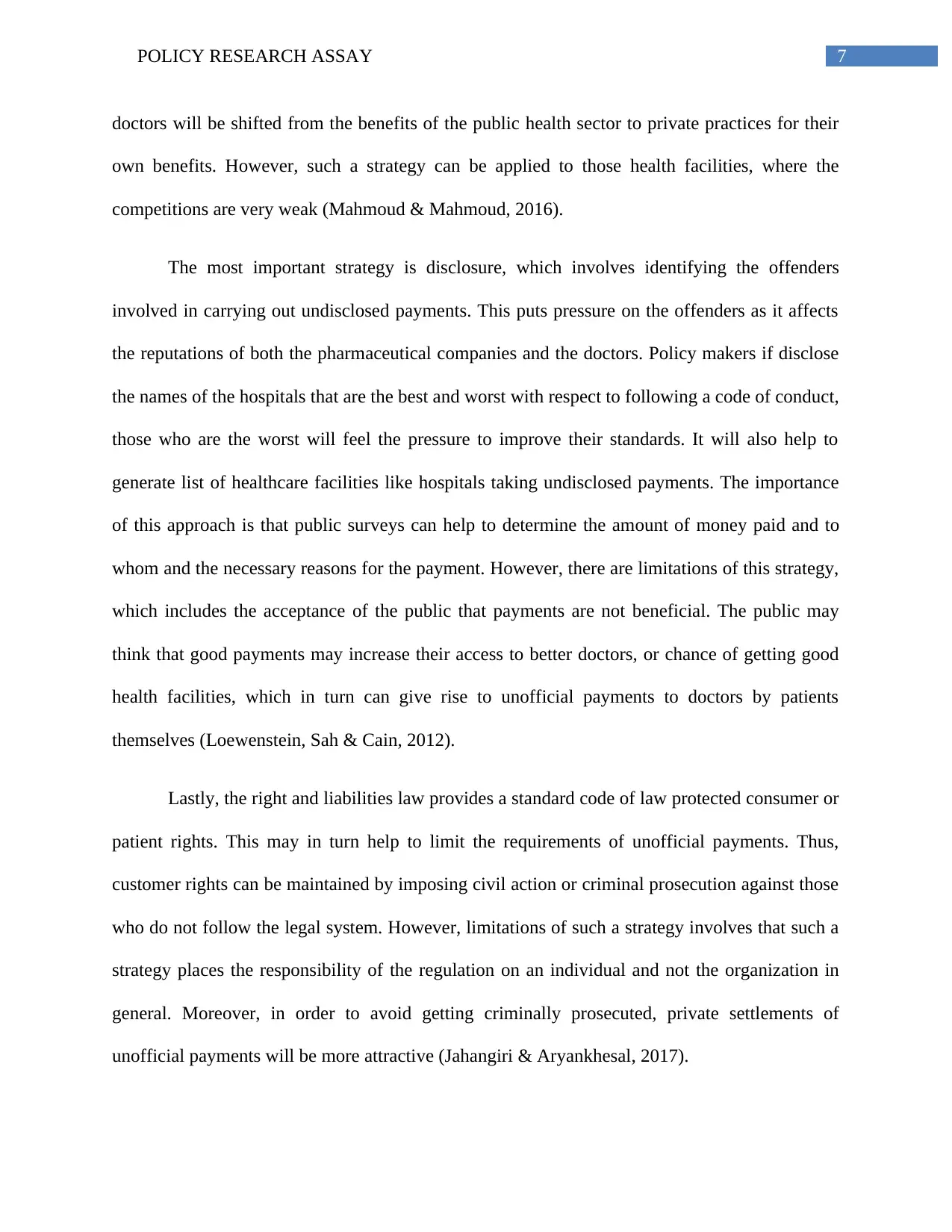
7POLICY RESEARCH ASSAY
doctors will be shifted from the benefits of the public health sector to private practices for their
own benefits. However, such a strategy can be applied to those health facilities, where the
competitions are very weak (Mahmoud & Mahmoud, 2016).
The most important strategy is disclosure, which involves identifying the offenders
involved in carrying out undisclosed payments. This puts pressure on the offenders as it affects
the reputations of both the pharmaceutical companies and the doctors. Policy makers if disclose
the names of the hospitals that are the best and worst with respect to following a code of conduct,
those who are the worst will feel the pressure to improve their standards. It will also help to
generate list of healthcare facilities like hospitals taking undisclosed payments. The importance
of this approach is that public surveys can help to determine the amount of money paid and to
whom and the necessary reasons for the payment. However, there are limitations of this strategy,
which includes the acceptance of the public that payments are not beneficial. The public may
think that good payments may increase their access to better doctors, or chance of getting good
health facilities, which in turn can give rise to unofficial payments to doctors by patients
themselves (Loewenstein, Sah & Cain, 2012).
Lastly, the right and liabilities law provides a standard code of law protected consumer or
patient rights. This may in turn help to limit the requirements of unofficial payments. Thus,
customer rights can be maintained by imposing civil action or criminal prosecution against those
who do not follow the legal system. However, limitations of such a strategy involves that such a
strategy places the responsibility of the regulation on an individual and not the organization in
general. Moreover, in order to avoid getting criminally prosecuted, private settlements of
unofficial payments will be more attractive (Jahangiri & Aryankhesal, 2017).
doctors will be shifted from the benefits of the public health sector to private practices for their
own benefits. However, such a strategy can be applied to those health facilities, where the
competitions are very weak (Mahmoud & Mahmoud, 2016).
The most important strategy is disclosure, which involves identifying the offenders
involved in carrying out undisclosed payments. This puts pressure on the offenders as it affects
the reputations of both the pharmaceutical companies and the doctors. Policy makers if disclose
the names of the hospitals that are the best and worst with respect to following a code of conduct,
those who are the worst will feel the pressure to improve their standards. It will also help to
generate list of healthcare facilities like hospitals taking undisclosed payments. The importance
of this approach is that public surveys can help to determine the amount of money paid and to
whom and the necessary reasons for the payment. However, there are limitations of this strategy,
which includes the acceptance of the public that payments are not beneficial. The public may
think that good payments may increase their access to better doctors, or chance of getting good
health facilities, which in turn can give rise to unofficial payments to doctors by patients
themselves (Loewenstein, Sah & Cain, 2012).
Lastly, the right and liabilities law provides a standard code of law protected consumer or
patient rights. This may in turn help to limit the requirements of unofficial payments. Thus,
customer rights can be maintained by imposing civil action or criminal prosecution against those
who do not follow the legal system. However, limitations of such a strategy involves that such a
strategy places the responsibility of the regulation on an individual and not the organization in
general. Moreover, in order to avoid getting criminally prosecuted, private settlements of
unofficial payments will be more attractive (Jahangiri & Aryankhesal, 2017).
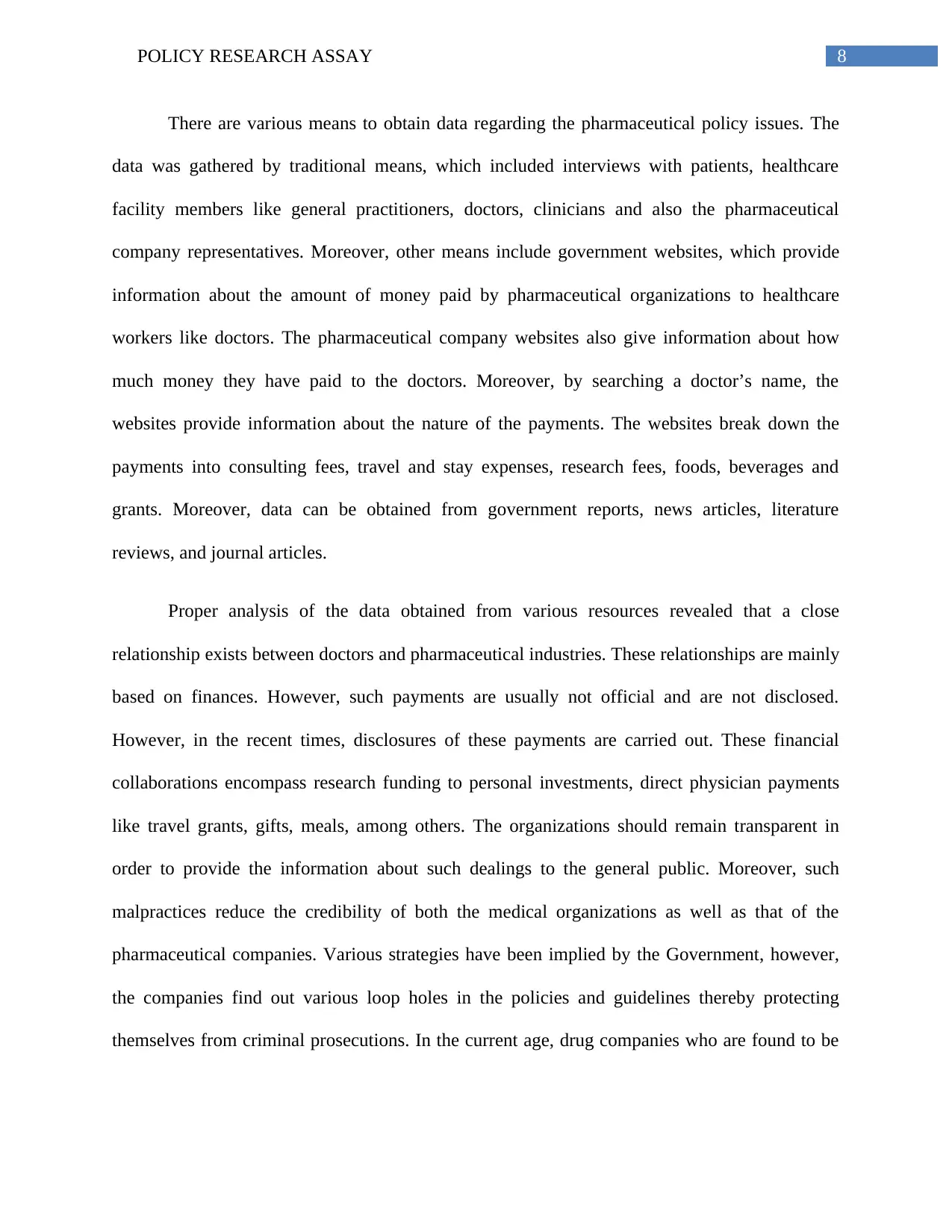
8POLICY RESEARCH ASSAY
There are various means to obtain data regarding the pharmaceutical policy issues. The
data was gathered by traditional means, which included interviews with patients, healthcare
facility members like general practitioners, doctors, clinicians and also the pharmaceutical
company representatives. Moreover, other means include government websites, which provide
information about the amount of money paid by pharmaceutical organizations to healthcare
workers like doctors. The pharmaceutical company websites also give information about how
much money they have paid to the doctors. Moreover, by searching a doctor’s name, the
websites provide information about the nature of the payments. The websites break down the
payments into consulting fees, travel and stay expenses, research fees, foods, beverages and
grants. Moreover, data can be obtained from government reports, news articles, literature
reviews, and journal articles.
Proper analysis of the data obtained from various resources revealed that a close
relationship exists between doctors and pharmaceutical industries. These relationships are mainly
based on finances. However, such payments are usually not official and are not disclosed.
However, in the recent times, disclosures of these payments are carried out. These financial
collaborations encompass research funding to personal investments, direct physician payments
like travel grants, gifts, meals, among others. The organizations should remain transparent in
order to provide the information about such dealings to the general public. Moreover, such
malpractices reduce the credibility of both the medical organizations as well as that of the
pharmaceutical companies. Various strategies have been implied by the Government, however,
the companies find out various loop holes in the policies and guidelines thereby protecting
themselves from criminal prosecutions. In the current age, drug companies who are found to be
There are various means to obtain data regarding the pharmaceutical policy issues. The
data was gathered by traditional means, which included interviews with patients, healthcare
facility members like general practitioners, doctors, clinicians and also the pharmaceutical
company representatives. Moreover, other means include government websites, which provide
information about the amount of money paid by pharmaceutical organizations to healthcare
workers like doctors. The pharmaceutical company websites also give information about how
much money they have paid to the doctors. Moreover, by searching a doctor’s name, the
websites provide information about the nature of the payments. The websites break down the
payments into consulting fees, travel and stay expenses, research fees, foods, beverages and
grants. Moreover, data can be obtained from government reports, news articles, literature
reviews, and journal articles.
Proper analysis of the data obtained from various resources revealed that a close
relationship exists between doctors and pharmaceutical industries. These relationships are mainly
based on finances. However, such payments are usually not official and are not disclosed.
However, in the recent times, disclosures of these payments are carried out. These financial
collaborations encompass research funding to personal investments, direct physician payments
like travel grants, gifts, meals, among others. The organizations should remain transparent in
order to provide the information about such dealings to the general public. Moreover, such
malpractices reduce the credibility of both the medical organizations as well as that of the
pharmaceutical companies. Various strategies have been implied by the Government, however,
the companies find out various loop holes in the policies and guidelines thereby protecting
themselves from criminal prosecutions. In the current age, drug companies who are found to be
⊘ This is a preview!⊘
Do you want full access?
Subscribe today to unlock all pages.

Trusted by 1+ million students worldwide
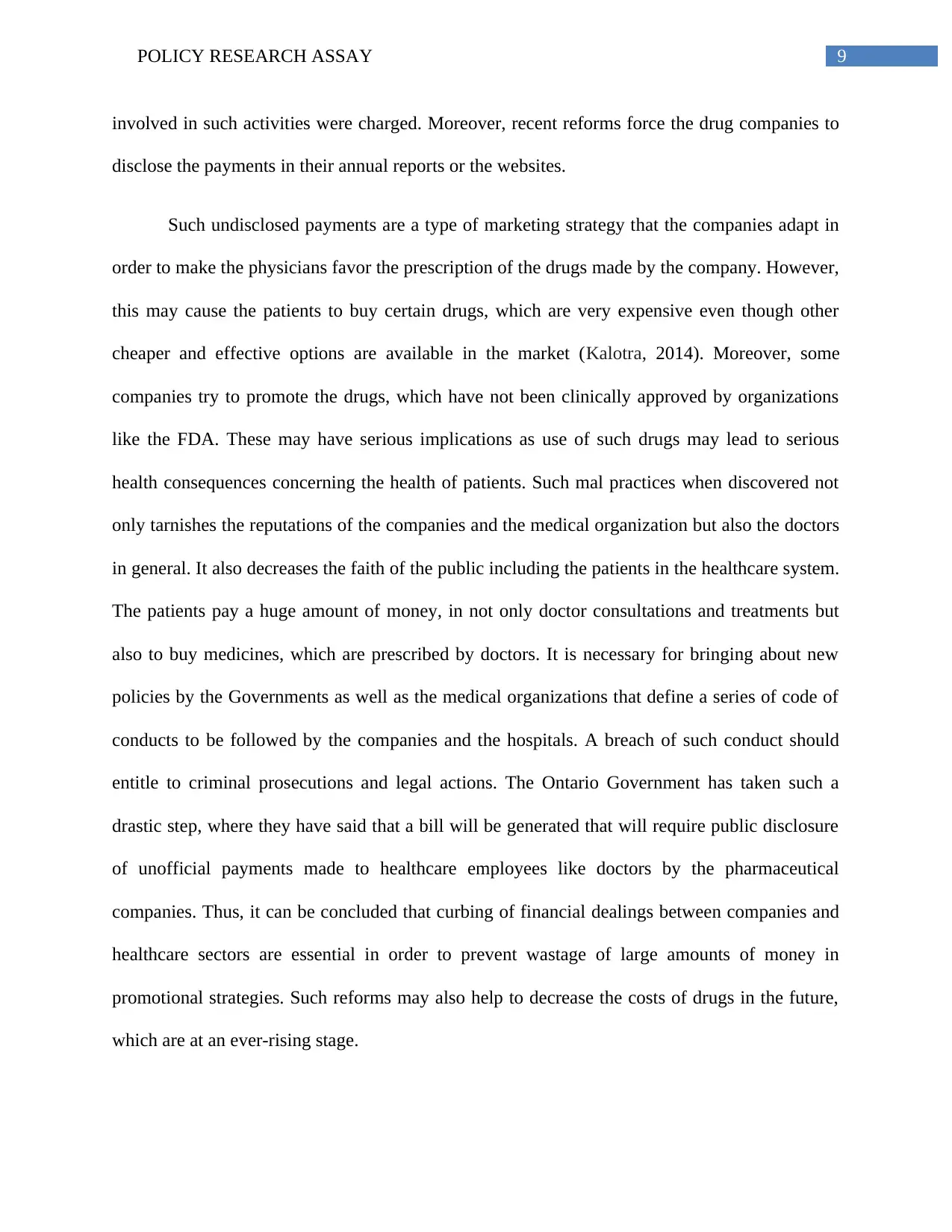
9POLICY RESEARCH ASSAY
involved in such activities were charged. Moreover, recent reforms force the drug companies to
disclose the payments in their annual reports or the websites.
Such undisclosed payments are a type of marketing strategy that the companies adapt in
order to make the physicians favor the prescription of the drugs made by the company. However,
this may cause the patients to buy certain drugs, which are very expensive even though other
cheaper and effective options are available in the market (Kalotra, 2014). Moreover, some
companies try to promote the drugs, which have not been clinically approved by organizations
like the FDA. These may have serious implications as use of such drugs may lead to serious
health consequences concerning the health of patients. Such mal practices when discovered not
only tarnishes the reputations of the companies and the medical organization but also the doctors
in general. It also decreases the faith of the public including the patients in the healthcare system.
The patients pay a huge amount of money, in not only doctor consultations and treatments but
also to buy medicines, which are prescribed by doctors. It is necessary for bringing about new
policies by the Governments as well as the medical organizations that define a series of code of
conducts to be followed by the companies and the hospitals. A breach of such conduct should
entitle to criminal prosecutions and legal actions. The Ontario Government has taken such a
drastic step, where they have said that a bill will be generated that will require public disclosure
of unofficial payments made to healthcare employees like doctors by the pharmaceutical
companies. Thus, it can be concluded that curbing of financial dealings between companies and
healthcare sectors are essential in order to prevent wastage of large amounts of money in
promotional strategies. Such reforms may also help to decrease the costs of drugs in the future,
which are at an ever-rising stage.
involved in such activities were charged. Moreover, recent reforms force the drug companies to
disclose the payments in their annual reports or the websites.
Such undisclosed payments are a type of marketing strategy that the companies adapt in
order to make the physicians favor the prescription of the drugs made by the company. However,
this may cause the patients to buy certain drugs, which are very expensive even though other
cheaper and effective options are available in the market (Kalotra, 2014). Moreover, some
companies try to promote the drugs, which have not been clinically approved by organizations
like the FDA. These may have serious implications as use of such drugs may lead to serious
health consequences concerning the health of patients. Such mal practices when discovered not
only tarnishes the reputations of the companies and the medical organization but also the doctors
in general. It also decreases the faith of the public including the patients in the healthcare system.
The patients pay a huge amount of money, in not only doctor consultations and treatments but
also to buy medicines, which are prescribed by doctors. It is necessary for bringing about new
policies by the Governments as well as the medical organizations that define a series of code of
conducts to be followed by the companies and the hospitals. A breach of such conduct should
entitle to criminal prosecutions and legal actions. The Ontario Government has taken such a
drastic step, where they have said that a bill will be generated that will require public disclosure
of unofficial payments made to healthcare employees like doctors by the pharmaceutical
companies. Thus, it can be concluded that curbing of financial dealings between companies and
healthcare sectors are essential in order to prevent wastage of large amounts of money in
promotional strategies. Such reforms may also help to decrease the costs of drugs in the future,
which are at an ever-rising stage.
Paraphrase This Document
Need a fresh take? Get an instant paraphrase of this document with our AI Paraphraser
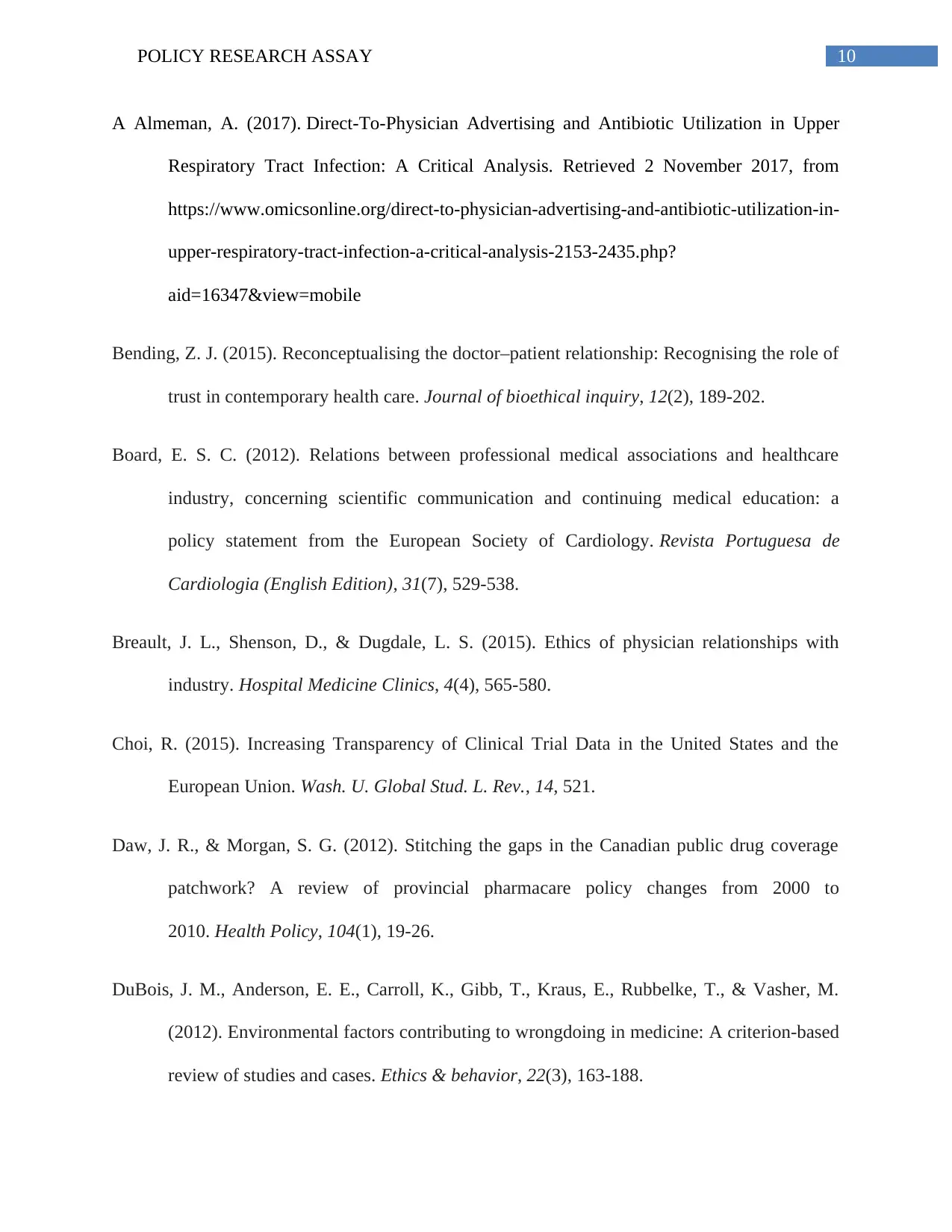
10POLICY RESEARCH ASSAY
A Almeman, A. (2017). Direct-To-Physician Advertising and Antibiotic Utilization in Upper
Respiratory Tract Infection: A Critical Analysis. Retrieved 2 November 2017, from
https://www.omicsonline.org/direct-to-physician-advertising-and-antibiotic-utilization-in-
upper-respiratory-tract-infection-a-critical-analysis-2153-2435.php?
aid=16347&view=mobile
Bending, Z. J. (2015). Reconceptualising the doctor–patient relationship: Recognising the role of
trust in contemporary health care. Journal of bioethical inquiry, 12(2), 189-202.
Board, E. S. C. (2012). Relations between professional medical associations and healthcare
industry, concerning scientific communication and continuing medical education: a
policy statement from the European Society of Cardiology. Revista Portuguesa de
Cardiologia (English Edition), 31(7), 529-538.
Breault, J. L., Shenson, D., & Dugdale, L. S. (2015). Ethics of physician relationships with
industry. Hospital Medicine Clinics, 4(4), 565-580.
Choi, R. (2015). Increasing Transparency of Clinical Trial Data in the United States and the
European Union. Wash. U. Global Stud. L. Rev., 14, 521.
Daw, J. R., & Morgan, S. G. (2012). Stitching the gaps in the Canadian public drug coverage
patchwork? A review of provincial pharmacare policy changes from 2000 to
2010. Health Policy, 104(1), 19-26.
DuBois, J. M., Anderson, E. E., Carroll, K., Gibb, T., Kraus, E., Rubbelke, T., & Vasher, M.
(2012). Environmental factors contributing to wrongdoing in medicine: A criterion-based
review of studies and cases. Ethics & behavior, 22(3), 163-188.
A Almeman, A. (2017). Direct-To-Physician Advertising and Antibiotic Utilization in Upper
Respiratory Tract Infection: A Critical Analysis. Retrieved 2 November 2017, from
https://www.omicsonline.org/direct-to-physician-advertising-and-antibiotic-utilization-in-
upper-respiratory-tract-infection-a-critical-analysis-2153-2435.php?
aid=16347&view=mobile
Bending, Z. J. (2015). Reconceptualising the doctor–patient relationship: Recognising the role of
trust in contemporary health care. Journal of bioethical inquiry, 12(2), 189-202.
Board, E. S. C. (2012). Relations between professional medical associations and healthcare
industry, concerning scientific communication and continuing medical education: a
policy statement from the European Society of Cardiology. Revista Portuguesa de
Cardiologia (English Edition), 31(7), 529-538.
Breault, J. L., Shenson, D., & Dugdale, L. S. (2015). Ethics of physician relationships with
industry. Hospital Medicine Clinics, 4(4), 565-580.
Choi, R. (2015). Increasing Transparency of Clinical Trial Data in the United States and the
European Union. Wash. U. Global Stud. L. Rev., 14, 521.
Daw, J. R., & Morgan, S. G. (2012). Stitching the gaps in the Canadian public drug coverage
patchwork? A review of provincial pharmacare policy changes from 2000 to
2010. Health Policy, 104(1), 19-26.
DuBois, J. M., Anderson, E. E., Carroll, K., Gibb, T., Kraus, E., Rubbelke, T., & Vasher, M.
(2012). Environmental factors contributing to wrongdoing in medicine: A criterion-based
review of studies and cases. Ethics & behavior, 22(3), 163-188.
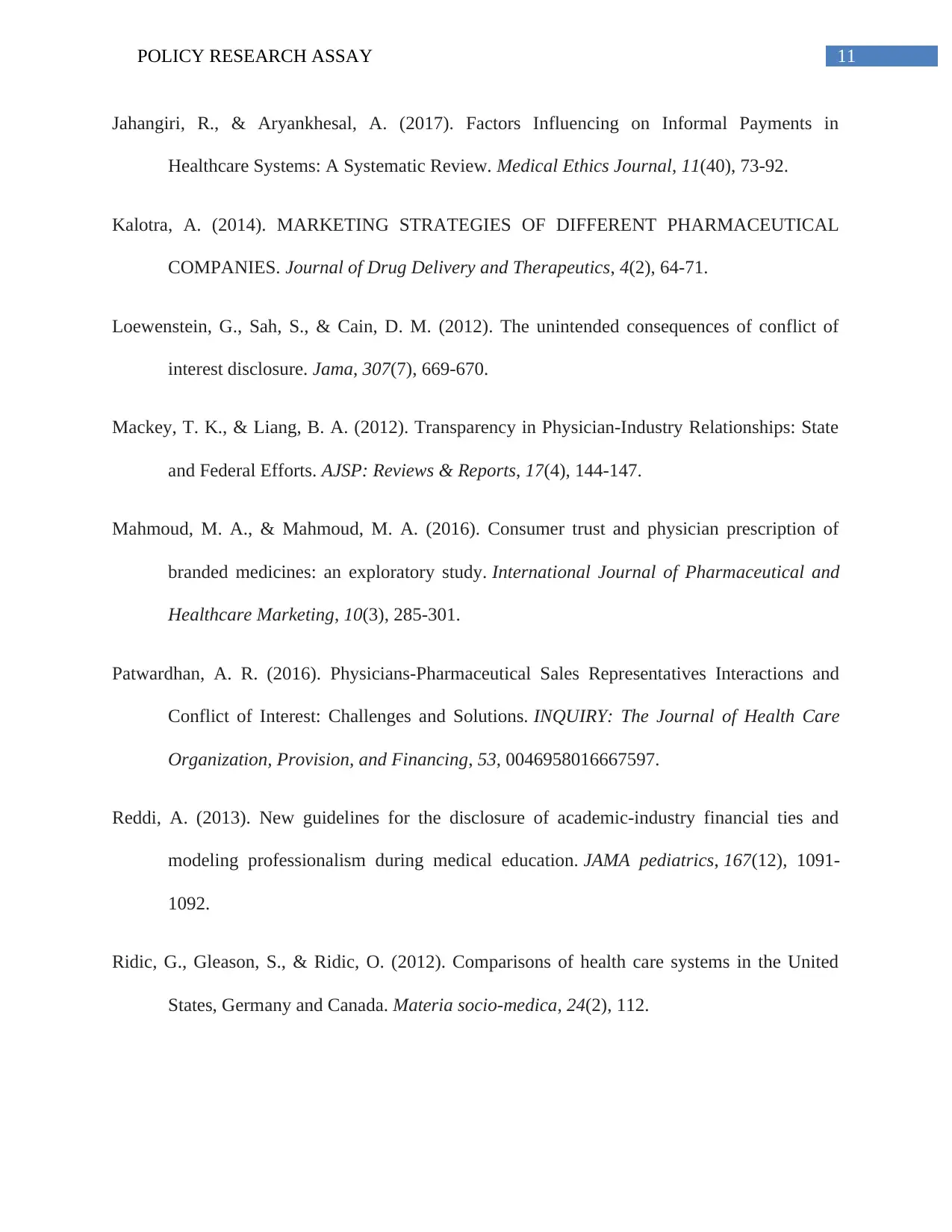
11POLICY RESEARCH ASSAY
Jahangiri, R., & Aryankhesal, A. (2017). Factors Influencing on Informal Payments in
Healthcare Systems: A Systematic Review. Medical Ethics Journal, 11(40), 73-92.
Kalotra, A. (2014). MARKETING STRATEGIES OF DIFFERENT PHARMACEUTICAL
COMPANIES. Journal of Drug Delivery and Therapeutics, 4(2), 64-71.
Loewenstein, G., Sah, S., & Cain, D. M. (2012). The unintended consequences of conflict of
interest disclosure. Jama, 307(7), 669-670.
Mackey, T. K., & Liang, B. A. (2012). Transparency in Physician-Industry Relationships: State
and Federal Efforts. AJSP: Reviews & Reports, 17(4), 144-147.
Mahmoud, M. A., & Mahmoud, M. A. (2016). Consumer trust and physician prescription of
branded medicines: an exploratory study. International Journal of Pharmaceutical and
Healthcare Marketing, 10(3), 285-301.
Patwardhan, A. R. (2016). Physicians-Pharmaceutical Sales Representatives Interactions and
Conflict of Interest: Challenges and Solutions. INQUIRY: The Journal of Health Care
Organization, Provision, and Financing, 53, 0046958016667597.
Reddi, A. (2013). New guidelines for the disclosure of academic-industry financial ties and
modeling professionalism during medical education. JAMA pediatrics, 167(12), 1091-
1092.
Ridic, G., Gleason, S., & Ridic, O. (2012). Comparisons of health care systems in the United
States, Germany and Canada. Materia socio-medica, 24(2), 112.
Jahangiri, R., & Aryankhesal, A. (2017). Factors Influencing on Informal Payments in
Healthcare Systems: A Systematic Review. Medical Ethics Journal, 11(40), 73-92.
Kalotra, A. (2014). MARKETING STRATEGIES OF DIFFERENT PHARMACEUTICAL
COMPANIES. Journal of Drug Delivery and Therapeutics, 4(2), 64-71.
Loewenstein, G., Sah, S., & Cain, D. M. (2012). The unintended consequences of conflict of
interest disclosure. Jama, 307(7), 669-670.
Mackey, T. K., & Liang, B. A. (2012). Transparency in Physician-Industry Relationships: State
and Federal Efforts. AJSP: Reviews & Reports, 17(4), 144-147.
Mahmoud, M. A., & Mahmoud, M. A. (2016). Consumer trust and physician prescription of
branded medicines: an exploratory study. International Journal of Pharmaceutical and
Healthcare Marketing, 10(3), 285-301.
Patwardhan, A. R. (2016). Physicians-Pharmaceutical Sales Representatives Interactions and
Conflict of Interest: Challenges and Solutions. INQUIRY: The Journal of Health Care
Organization, Provision, and Financing, 53, 0046958016667597.
Reddi, A. (2013). New guidelines for the disclosure of academic-industry financial ties and
modeling professionalism during medical education. JAMA pediatrics, 167(12), 1091-
1092.
Ridic, G., Gleason, S., & Ridic, O. (2012). Comparisons of health care systems in the United
States, Germany and Canada. Materia socio-medica, 24(2), 112.
⊘ This is a preview!⊘
Do you want full access?
Subscribe today to unlock all pages.

Trusted by 1+ million students worldwide
1 out of 14
Related Documents
Your All-in-One AI-Powered Toolkit for Academic Success.
+13062052269
info@desklib.com
Available 24*7 on WhatsApp / Email
![[object Object]](/_next/static/media/star-bottom.7253800d.svg)
Unlock your academic potential
Copyright © 2020–2025 A2Z Services. All Rights Reserved. Developed and managed by ZUCOL.





